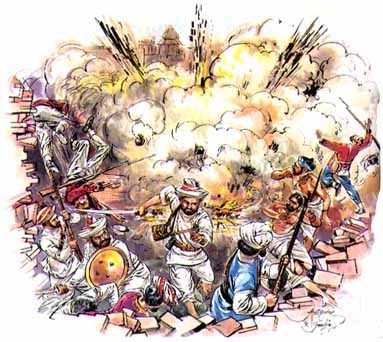THE WAR OF INDEPENDENCE:
|
THE WAR OF INDEPENDENCE: SEIZE CONTROL OF DELHI, MAY 11, 1857 A.D. |
|
Having killed the European officers and some newly-converted Christians, they now fell upon the Delhi Bank, which situated in the heart of city--close to Chandni Chowk. The bags of money were carried away by men which however, were later seized by the Revolutionary forces. The jail prisoners got released and fetters removed. The Treasury was plundered by the sepoys, but they surrendered its contents to the Emperor. In the afternoon of the fateful day the most important incident was the explosion of the Magazine, not far from the Emperor's Palace. It contained vast stores of ammunition and a fairly large staff under the command of Lt. George Willoughby.
Willoughby had, however, became alert and made preparations for defence, because he knew that the Revolutionaries would demand its possession. The outer gates were barricaded and guns placed inside them; at the same time 'a train was laid from the powder store to a tree standing in the yard of the Magazine'. Conductor Scully was posted and was to fire the train on receiving a signal in case the defence failed. A messenger had come from the Emperor to say that 'if you do not immediately open the gates, we would have scaling ladders sent down to scale the walls'. The Revolutionaries, therefore, set the scaling ladders in position, and this was followed by a fight which demonstrated how determined the parties were to stick their respective causes and to what extent the individuals participating were prepared to go in making sacrifices for them. As they streamed over the walls, round after round of murderous grapeshot from Europeans' guns, delivered with all the coolness and steadiness of a practice-parade, riddled the advancing multitudes; but still they poured on. Willoughby took the fatal step. He gave the signal; and the train was fired. In a moment the Magazine exploded, killing 25 sepoys and a mob of 400 onlookers perished. |

